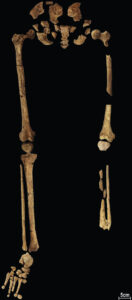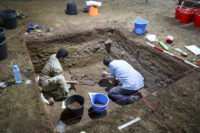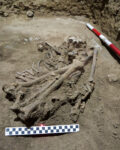 A 31,000-year-old skeleton found in the Liang Tebo cave of Indonesian Borneo has a surgically amputated leg. It is by far the oldest surgical amputation ever found, and completely upends our understanding of the development of prehistoric medicine.
A 31,000-year-old skeleton found in the Liang Tebo cave of Indonesian Borneo has a surgically amputated leg. It is by far the oldest surgical amputation ever found, and completely upends our understanding of the development of prehistoric medicine.
The previous record-holder, a Neolithic farmer with an amputated left forearm found in France, is only about 7,000 years old. The prevailing thought was that the growth of medicine followed the Agricultural Revolution as the transition from the active hunter-gatherer lifestyle to the more sedentary farming lifestyle gave rise to new health problems. The scholarship consensus was that complex medical procedures like surgical amputation which require detailed knowledge of anatomy, at least enough pharmacology to stave off infection and technical abilities, were only achieved after people settled down around 10,000 years ago.
 The discovery of the young man in Borneo who lived more than 20,000 years before the Neolithic Revolution and not only had a third of his lower left leg removed, but who lived another six-nine years after the surgery, indicates hunter-gatherer groups at least in Asia had developed advanced medical skills millennia before the introduction of farming.
The discovery of the young man in Borneo who lived more than 20,000 years before the Neolithic Revolution and not only had a third of his lower left leg removed, but who lived another six-nine years after the surgery, indicates hunter-gatherer groups at least in Asia had developed advanced medical skills millennia before the introduction of farming.
The skeleton was unearthed in 2020 in the central chamber of the Liang Tebo cave. The body was inhumed in a flexed position with the right knee bent against the chest and the left knee flexed below the pelvis. All of the bones of his right foot are present and accounted for; there is no left foot. Flaked chert from flintknapping and a piece of red ochre were buried with the remains. Limestone rocks were placed on the infilled grave above the head and arms, likely as burial markers.
 Fragments of the left tibia and fibula shafts recovered from under the left femur show a clean, slanted cut covered by remodelled bone. Non-surgical amputation, as from an accident, could not have produced the oblique sectioning of the bone, neither could an animal attacks or blunt force trauma. Also, animal bites in this period almost always caused infection, and there is no evidence of infection in the bone.
Fragments of the left tibia and fibula shafts recovered from under the left femur show a clean, slanted cut covered by remodelled bone. Non-surgical amputation, as from an accident, could not have produced the oblique sectioning of the bone, neither could an animal attacks or blunt force trauma. Also, animal bites in this period almost always caused infection, and there is no evidence of infection in the bone.
This shows that the prehistoric foragers knew enough about medicine to perform the surgery without fatal blood loss or infection, the authors concluded. Researchers don’t know what kind of tool was used to amputate the limb, or how infection was prevented — but they speculate that a sharp stone tool may have made the cut, and point out that some of the rich plant life in the region has medicinal properties.
About 20 years old at the time of death, the young man was a boy when his lower leg was removed. The surviving sections of his left tibia and fibula are smaller than the ones of his right leg because they stopped growing after the surgery. He was likely no older than 12 and lived into early adulthood despite his injury. The bones of his left leg show evidence of severe muscular atrophy, and even his intact right leg bore markers of atrophy, suggesting he had very limited mobility and had to have been cared for until his death.
The discovery has been published in the journal Nature and can be read in its entirety here.